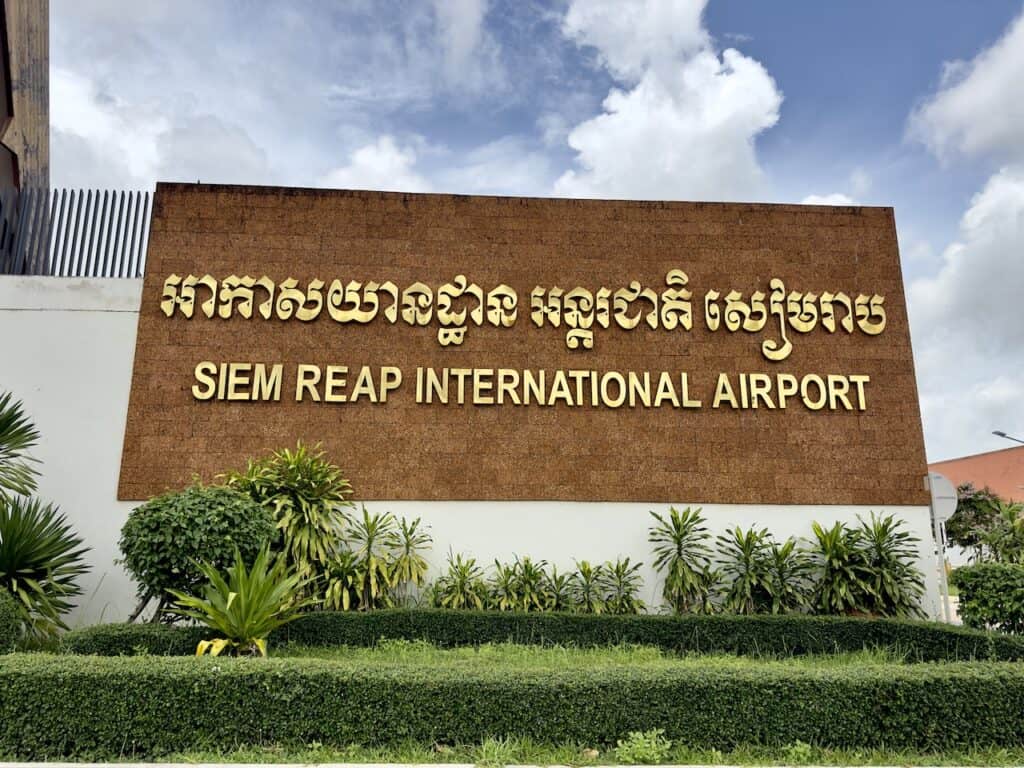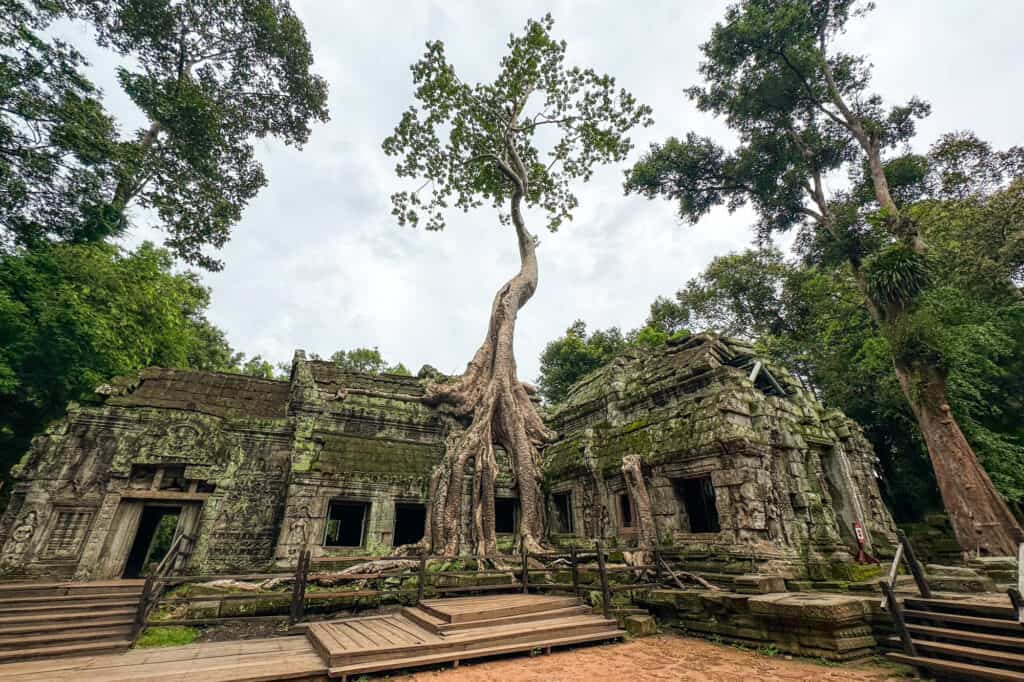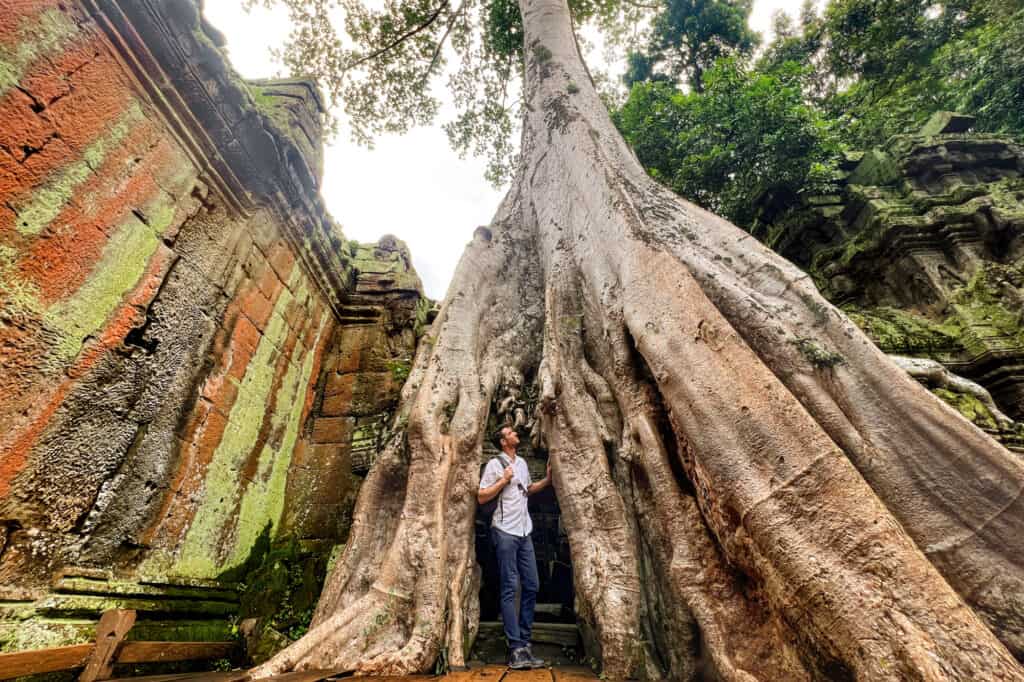Siem Reap Airport: Gateway to Angkor Wat in Cambodia
Siem Reap International Airport (IATA: REP) is the main airport serving Siem Reap, Cambodia. It is the primary gateway for travelers visiting the Angkor Wat temples and the surrounding area.
If you’re already in Cambodia, you’ll likely be flying the national airline: Angkor Air.
Otherwise, international flights are available from Ho Chi Minh City, Bangkok, Hanoi, and other cities in Southeast Asia.
Siem Reap Airport Info
The airport is fairly large, but not very busy. Even though the city of Siem Reap is inland, the airport’s exterior reminds me of the tropical airports you’ll find on the Hawaiian Islands.
Here is some basic information about what to expect if you’re flying into Siem Reap’s airport:
- Terminals: The airport has a single terminal building that handles both domestic and international flights.
- Runways: Siem Reap International Airport has one runway, which is approximately 3,300 meters (10,827 feet) in length.
- Passenger Services: The airport provides a range of services for passengers, including immigration and customs facilities, car rental services, currency exchange, duty-free shops, restaurants, and transportation options to the city center.
- Visa on Arrival: For many travelers arriving in Siem Reap, the airport offers visa-on-arrival services. It’s far easier to get a visa online before your trip to Cambodia. After applying and paying online, you should have the visa emailed to you within a few days.
PRO TIP: The flights out of Siem Reap’s airport have a reputation for leaving early! If the passengers are all checked in, it’s not uncommon for a flight to leave 30 minutes before its scheduled departure. This is especially true for domestic flights to other Cambodian cities!
REP Airport Departures
The check-in hall is large and gleaming.
Don’t expect much of a crowd in the off-season. You’ll have far more people in the lines here from November through February (the dry season) when tourism picks up.
You’ll have to scan your passport after checking-in, on your way to the metal detectors and luggage scanners.
If you haven’t had a chance to pick up Cambodian products or souvenirs, this is your chance. Siem Reap’s airport has several stores, full of stuff to buy.
You’ll also find a coffee and sandwich shop between the gates, along with a large bar and restaurant.
The gate areas are pretty basic, but there are a few outlets to plug your devices into while you wait to board.
REP Airport Arrivals
Your plane is likely to park away from the terminal, so you’ll walk across the tarmac into the airport.
Inside, the baggage carousel area is large, clean, and likely not too busy.
The only store you’ll see on your way out is a Duty Free shop.
There’s a Circle K convenience store after you exit.
You’ll also find a bank of ATMs outside. At least two of them dispense US dollars, which are accepted as currency everywhere in Cambodia. Expect to pay a $5 surcharge on a cash withdrawal.
Tours from Siem Reap
There’s no need to pre-arrange an airport pickup. Just take a tuk-tuk into town, or right to the temples (see the next section). If you’re in Siem Reap for a few days, I would recommend these highly-rated tours:
➡️ Click to Book: Angkor Wat Sunrise
➡️ Click to Book: Angkor Wat & Other Temples
➡️ Click to Book: National Park Waterfalls
Where to Stay in Siem Reap
You can use the interactive map below to plug in your travel dates and search for hotels and VRBO rentals:
Transportation from Siem Reap Airport
They cater to tourists at Siem Reap’s airport. You’ll find a taxi office as soon as you exit.
While I dread these encounters in a lot of cities, the people of Cambodia truly are not trying to take advantage of tourists. They offer very fair rates for transportation, so I don’t think haggling is necessary.
They’ll likely give you the option of a tuk-tuk or a taxi. The staff keeps a fleet of both parked right outside.
The day rate for a driver (including airport pickup, transportation to the temples, and a ride to the city or hotels) is about $50 USD.
Airlines Flying to Siem Reap
Several international and domestic airlines operate flights to and from Siem Reap International Airport. Some of the airlines that have historically flown to Siem Reap include:
International Airlines Serving Siem Reap:
- Cambodia Angkor Air
- AirAsia
- Bangkok Airways
- Malaysia Airlines
- SilkAir (a subsidiary of Singapore Airlines)
- China Southern Airlines
- Vietnam Airlines
- Qatar Airways
- Emirates
- Korean Air
Domestic Airlines Serving Siem Reap:
- Cambodia Angkor Air (domestic flights within Cambodia)
- Lanmei Airlines (domestic flights within Cambodia)
Cambodia’s Angkor Air (Airline)
Cambodia Angkor Air is the national flag carrier and largest airline in Cambodia. It has a very small fleet of planes, but a solid safety record.
Flights can be on the pricey side. While base fares are often as low as $75 each way from Phnom Penh to Siem Reap, the airline adds significant taxes to your final tally.
As an example, a $200 roundtrip fare will likely end up costing $350 or more after taxes are added.
The seats are basic, and there are no electrical outlets or other amenities on these short flights.
- History: Cambodia Angkor Air was established in 2009 as a joint venture between the Cambodian government and Vietnam Airlines, Vietnam’s national carrier. It was created to meet the growing demand for air travel to and from Cambodia, particularly to the tourist destination of Siem Reap, which is the gateway to the Angkor Wat temple complex.
- Fleet: Cambodia Angkor Air operates a small fleet. It has just a handful of Airbus A320 and A321 models, along with smaller ATR-72s. Those twin-engine prop planes are used for both domestic and international flights.
- Domestic Destinations: Domestically, Angkor Air connects Phnom Penh, Siem Reap, and Sihanoukville, within Cambodia.
- International Destinations: Angkor Air flies to several destinations in Asia, including Bangkok, Hanoi, Ho Chi Minh City, Seoul, Beijing, and Shanghai.
- In-Flight Services: Services are minimal, especially on short routes. If you’re flying the 40-minute flight to or from Phnom Penh, expect a cup of water.
- Code-Share Agreements: Cambodia Angkor Air has code-share agreements with other airlines, including Vietnam Airlines.
- Catering to Tourists: Cambodia Angkor Air caters to tourists visiting Cambodia. Announcements are made in English and other languages to accommodate international passengers.
REP Airport Restaurants and Stores
While the only store you’ll see when you land is a Duty Free shop, you’ll find plenty of stores and restaurants in the departure area.
By the check-in area, there’s a small cafe serving coffee and food.
Siem Reap Airport Expansion
Siem Reap International Airport has undergone significant developments and expansions in recent years to accommodate the growing number of tourists visiting the Angkor Wat temples. The airport has seen increased international and domestic flight connections to cater to the tourism industry in the region.
Here are some key points about tourism growth in Siem Reap:
- Angkor Wat’s Global Attraction: Angkor Wat, a UNESCO World Heritage site, is one of the most iconic and well-preserved temple complexes in the world. Its historical significance and architectural grandeur have made it a major global tourist attraction.
- Visitor Numbers: Siem Reap has experienced a substantial increase in tourist arrivals over the years. The number of international tourists visiting the region has steadily grown, contributing significantly to Cambodia’s tourism industry.
- Economic Impact: Tourism has become a vital component of the local economy in Siem Reap. It has generated employment opportunities for local residents, in the hospitality, transportation, and service sectors.
- Infrastructure Development: The growth of tourism has led to the development of infrastructure and amenities to cater to the needs of travelers. This includes the expansion and upgrade of Siem Reap International Airport, the construction of new hotels and resorts, and the development of dining and entertainment options.
- Challenges: The rapid growth of tourism has presented some challenges, including issues related to over-tourism, environmental conservation, and ensuring equitable distribution of economic benefits to local communities. Efforts have been made to address these challenges while continuing to promote tourism.
Siem Reap Airport FAQ’s
Let’s tackle a few frequently asked questions about flying to Siem Reap’s airport.
Can you fly from the US to Siem Reap?
There are no flights from the United States to Siem Reap.
How far is Siem Reap’s airport from the city?
From the airport to downtown Siem Reap, it’s about 10 kilometers. On a tuk-tuk, it’ll take about 20 minutes to get from the airport to the downtown area.
How far is Siem Reap’s airport from Angkor Wat?
It’s only a 5 or 6-kilometer drive from Siem Reap International Airport to the temples at Angkor Wat. By tuk-tuk, it’ll take about 10 minutes to get from the airport to the temples.
Check out our other posts about travel in Cambodia and Southeast Asia!























